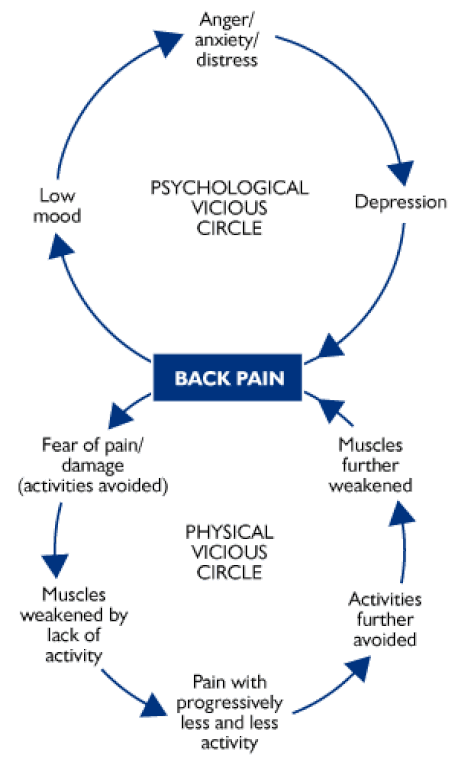Everyone experiences aches and pains either due to injury or after unfamiliar activities such as exercise and gardening. These symptoms are usually short lasting and not troublesome. Generally, the intensity of common aches and pains roughly match the physical condition. Additionally, people who suffer recurring pain such as headaches or menstrual pain recognise that while it may be unpleasant, it is not threatening. However, many people also experience pain that feels out of proportion to their injury or diagnosis and get little relief from medical care.
Chronic pain is defined as lasting longer than six months and extends beyond the expected period of healing. Chronic pain can arise from an initial injury such as a neck or back sprain or be due to an ongoing cause such as illness (1). People with chronic pain say their pain is triggered by things that are not normally painful (e.g., clothing, breeze) or that their pain continues long after a trigger has stopped. It is also common that over time, chronic pain becomes unpredictable and can spread to other parts of their body.


Prevalence
Studies highlight the considerable burden of chronic pain on both adults and children where in some countries chronic pain is experienced by about a third of the population. Prevalence in nearly all studies is higher in females and increases with age. Additionally, many people experience pain in many sites, especially in the low back, neck and legs. Importantly, chronic pain also has strong associations with anxiety, poor quality of life, low income and both physical and psychological trauma, especially in early life (6-9).
Researchers: Professor Philip Siddall, Dr Phil Austin, Professor Ali Asghari and Dr Dan Costa Site: Greenwich Hospital Duration: Feb 2014 to March 2018 Funding Source: Australia & NZ College of Anaesthetists Project Partners: University of Sydney Study Status: In Progress.
Psychological Impact
Central sensitisation refers to sensitisation of nerve pathways in parts of the brain that signal the intensity and character (e.g., ache, sharp etc). However, central sensitisation also occurs in pain pathways connecting with areas of the brain related to emotion, behaviour
A clinically relevant measure for assessing pain modulatory pathways
On completion of our research, it is hoped we can provide a new and simple technique for the assessment of persistent pain. By doing so, it will enable us to identify potential targets for treatment.
Type of pain
Musculoskeletal pain is started by nerve endings that signal because of tissue injury. These nerve endings are found in skin and muscles where pain feels localised, or in deeper structures such as ligaments and bones that is often more vague and difficult to localise. Nociceptive pain is described as sharp, aching or throbbing and normally decreases over time as tissue damage heals and typically responds well to anti-inflammatory (Ibuprofen) and opioid medication (Solpadol)
(2). Visceral pain is similar to nociceptive pain but arises from internal organs (e.g., gastrointestinal tract, gallbladder). Visceral pain is also triggered by smooth muscle contraction of the gastrointestinal tract (e.g., the passing of food, reaction to irritants) (3). Visceral pain is not very well defined and is described as deep, dull or dragging. It is often associated with other symptoms autonomic changes such as nausea, vomiting and changes in heart rate and blood pressure. Visceral pain also evokes strong emotional responses. Additionally, pain arising in these deeper sites often refer pain to body areas distant to the actual source of pain. For example, inflammation in the gallbladder (e.g., cholecystitis) often refers pain to the back of right shoulder (4).
Neuropathic pain is associated with injury to peripheral nerves or the central nervous system. These injuries cause symptoms such as numbness, tingling, electrical sensations and the unusual phenomenon where unbearable pain exists in an area that is numb to the touch (2).
Central sensitisation
With central sensitisation, nerves originating in the spinal cord are easily stimulated, increasing the strength and frequency of pain signals to the brain. As a result, the intensity and perception of pain is increased. Additionally, central sensitisation is strongly linked to the decreased ability of the brain to inhibit pain via nerve pathways going back down the spinal cord (5). As seen in the below figure, central sensitisation pain is characterised by allodynia (painful reaction to a stimulus that is not normally painful) and hyperalgesia (an increased painful reaction to a stimulus that is not normally very painful). Common pain conditions associated with central sensitisation are fibromyalgia, irritable bowel syndrome and tension headaches.
1. Landis S. Chronic Pain: Symptoms, Diagnosis & Treatment. NIH Medline Plus. 2011:5-6.
2. Taylor DR. Improving Outcomes in Acute Pain Management: Optimizing Patient Selection. Medscape Multispeciality [serial on the Internet]. 2004; 6(2).
3. Cervero F, Laird JM. Visceral pain. Lancet. 1999 Jun 19;353(9170):2145-8.
4. WebMD. Referred Shoulder Pain – Topic Overview. Pain Management Health Centre: WebMD; 2013.
5. Piche M, Bouin M, Arsenault M, Poitras P, Rainville P. Decreased pain inhibition in irritable bowel syndrome depends on altered descending modulation and higher-order brain processes. Neuroscience. 2011 Nov 10;195:166-75.
6. Johannes CB, Le TK, Zhou X, Johnston JA, Dworkin RH. The prevalence of chronic pain in United States adults: results of an Internet-based survey. J Pain. 2010 Nov;11(11):1230-9.
7. Schopflocher D, Taenzer P, Jovey R. The prevalence of chronic pain in Canada. Pain Res Manag. 2011 Nov-Dec;16(6):445-50.
8. Wong WS, Fielding R. Prevalence and characteristics of chronic pain in the general population of Hong Kong. J Pain. 2011 Feb;12(2):236-45.
9. Blyth FM, March LM, Brnabic AJ, Jorm LR, Williamson M, Cousins MJ. Chronic pain in Australia: a prevalence study. Pain. 2001 Jan;89(2-3):127-34.

